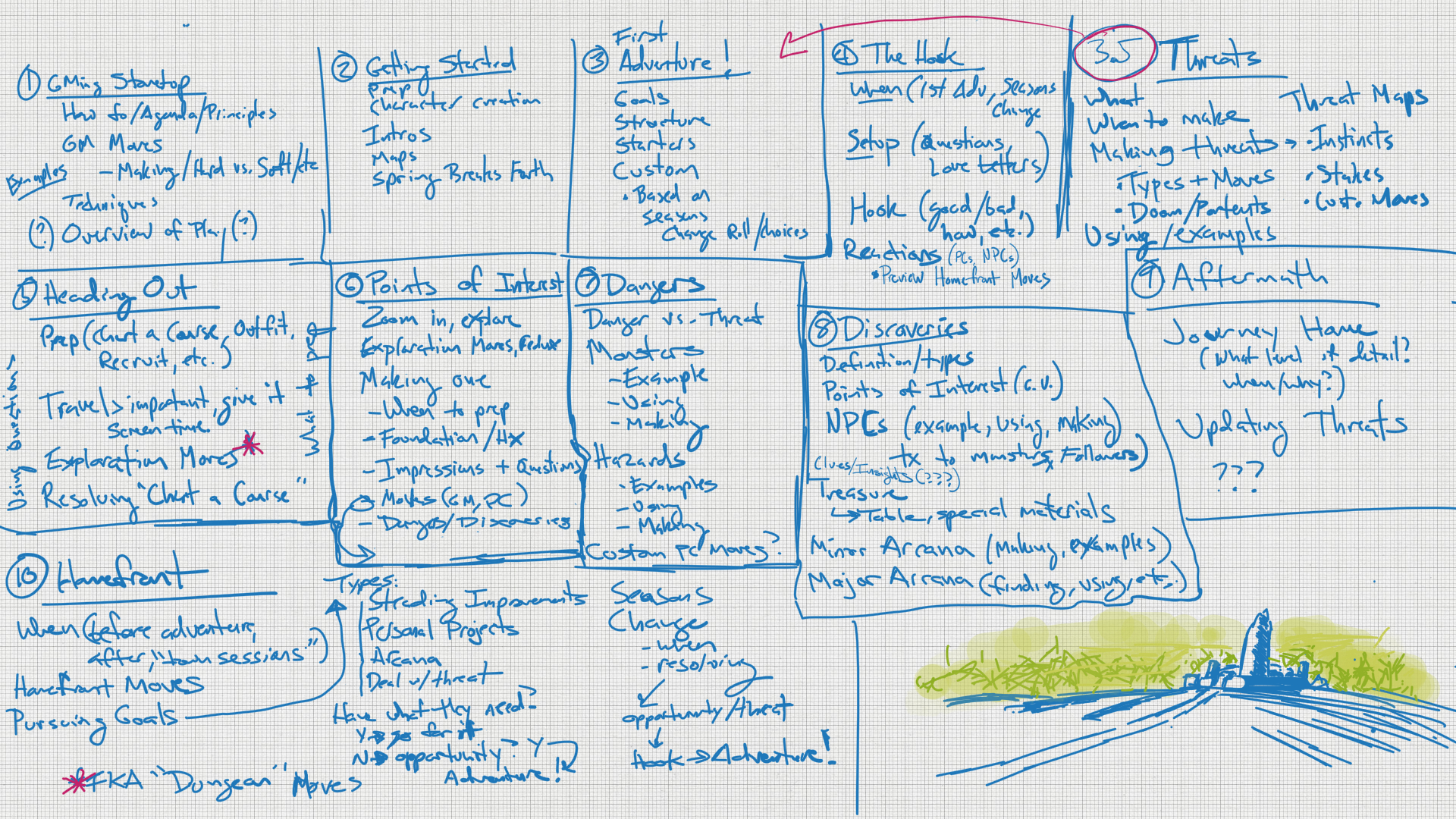
Here’s my chicken-scratch outline for what the GM section of Stonetop will look like.
I’ve been going round and round on how to organize these. Do I put all the “common” GM moves (basic, exploration/dungeon, homefront) in one section? Do I split them out? Where do I put the Homefront chapter? (Before “The Hook” or at the end?) Do I introduce Threats before the first adventure, or after?
Ultimately, I’ve opted for what I hope is a workflow-based/task-oriented approach: you get an overview of how to GM, then we talk about how get started (character creation, introductions) and leap into the first adventure. From there, look at the parts of each adventure, and what goes into them.
If you’re willing to wade through my chicken scratch, I’d love to hear thoughts and impressions on this.

Seems reasonable.
I’m assuming references will be linked?
Christo Meid how do you mean? Like, hyperlinks in a PDF?
Exactly!
I think it’s appropriate to put some info on threats in “First Adventure!” But I think it’s also appropriate to cover threats in detail (incl types, moves, threat maps, etc.) in the chapter on Dangers… and hopefully a summary page for use as a GM aid during play. 🙂
Michael Moch, I considered putting threats in with dangers, but so far I’m opting against it. Threats are more about planning and changing the strategic landscape; dangers are here-and-now problems you (probably) need to resolve. Ideally, I know my threats before I drop my hook. But I might not need to detail about dangers (monsters, hazards) until they appear on screen.
Strategic vs. tactical, basically.
I could be wrong, though! And (clearly, based on how I’ve wedged them in there), I’ve been playing with where to put them. The other logical place is all the way at the end, either part of Aftermath or in lieu of it.
As for a summary page…
drive.google.com – GM Playbook.pdf
Jeremy Strandberg The GM Playbook rocks!
I noticed a couple of what are probably errors on the Making Monsters page, under “DAMAGE & RANGE” and then “It’s armaments…”, the 4th bullet says “Cane tear metal apart.”
And then in the same column under “Choose all that apply:”, the first bullet says “Its primary dangerous isn’t from wounds”.
Also is (will) the “+/-range” prompts (be) explained elsewhere in the text? I noticed you had a key for the “+quality” and “+move” prompts. Seems like since +/-range is similar to those, it could also be explained there. That said, I can intuit what +/-range means, and I’m at a loss as how to explain it succinctly with words, so, whatevs. 🙂
These are really cool prompts for the DM, by the way, I instantly saw their utility. Very helpful. I will be printing this and will use this for my next DW game.
And I like what you’ve done so far with Stonetop, from what I’ve seen in the Google Docs folder you linked in another post. The re-worked basic moves, and again this GM playbook, how change of seasons is handled, etc. I was getting worried that you’d dropped the project, since it seemed like you hadn’t posted much about it for several weeks.
From your outline, it seems like you’re merging some AW2 concepts with DW for great justice. Since I read the AW2 book I’ve been thinking that I like those moves better, but I could see that it wasn’t really all that simple to adapt them to DW – a new PbtA hack would be required based on AW2. Mainly in my mind this is because of how harm/damage is handled in each game, but also alignment and bonds vs. Hx, etc.
I’ll wait for Stonetop to mature before I start on it. 🙂
Jeremy Strandberg Do you break the threat kinds down by impulse as in AW (e.g. Warlord has dictator, alpha wolf, etc.)?
Michael Moch No.
I think that (mostly) makes sense for Apocalypse World (with its relatively zoomed in genre), but I’ve always found it jarring in Dungeon World. Every time I look at the list of specific dangers and impulses in the DW Fronts chapter, I find myself feeling limited rather than inspired.
While Stonetop is arguably a more specific genre than DW, it’s still a pretty wide-open fantasy setting. I think a prescriptive list would run afoul of the same problem.
So instead, I’ll include a bunch of examples for each one. I thought about including some examples in the GM Playbook, but 1) space and 2) the examples I want to include need a little space and explanation to make sense.
Like, yeah, i could have a generic “Sorcerer” villain sub-type, with an instinct of “recklessly accumulate magical power.’
Or I could have Iwan, the villager who always had just terrible luck (because, really, he made bad decisions), who built up a cult in secret and ended up sacrificing one of the Hillfolk refugees to gain magical power, and unleashed that power on the PCs when caught, and then fled the village and started squatting and digging around in the Ruined Tower. His instinct is “Get what he thinks the world owes him.”
Iwan’s instinct is never going to show up in a generalized list of threat-types, but he’s a much richer character for having it.
(And my god, do the players hate this guy.)
I love the way you use DM moves behind the scenes to make players feel that world is alive. Specially Homefront.